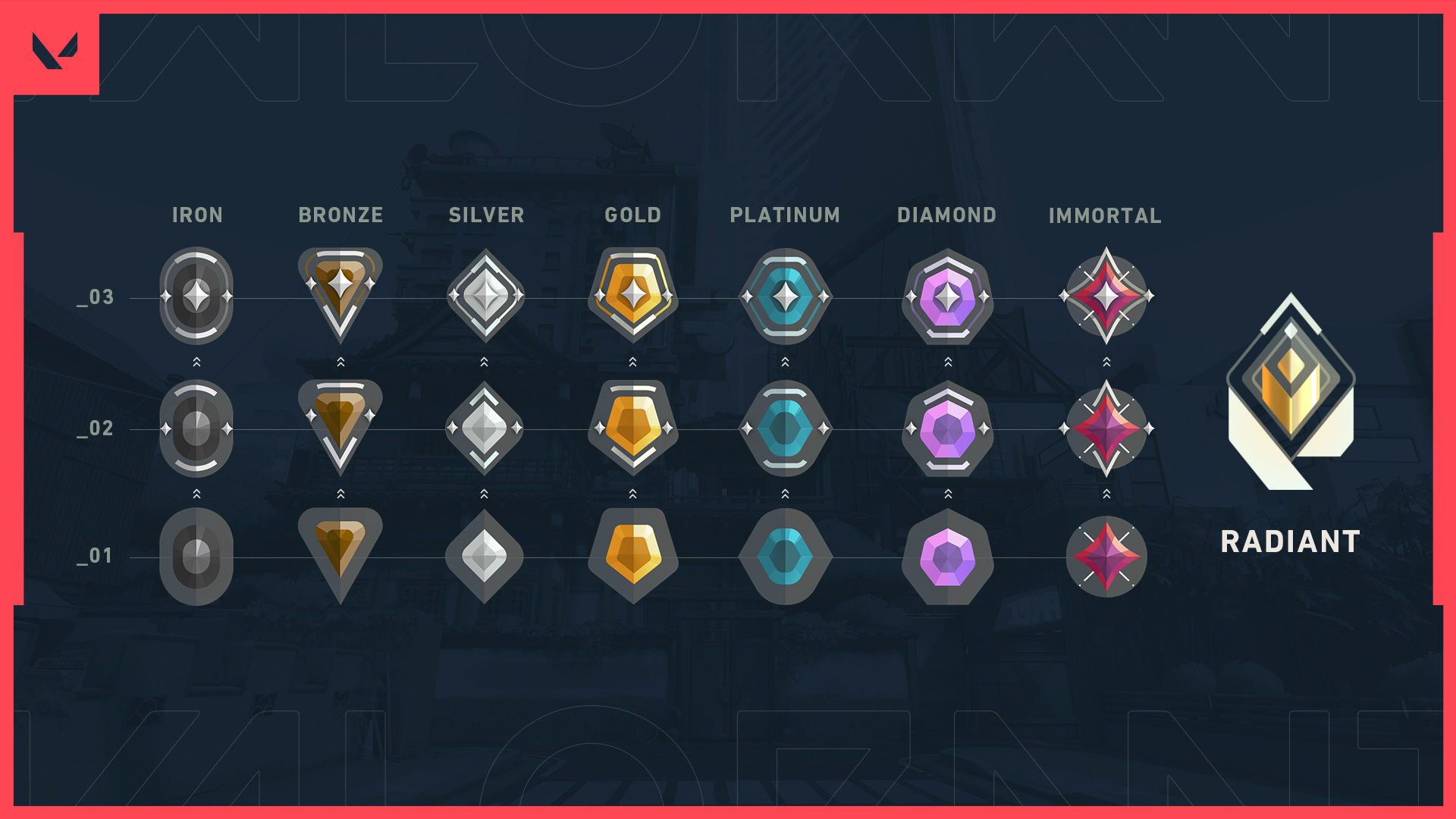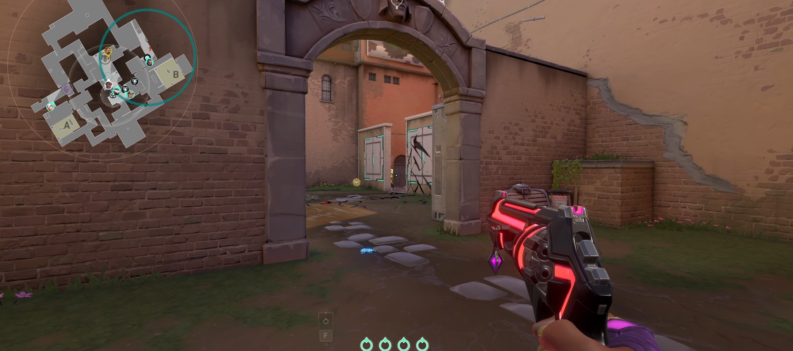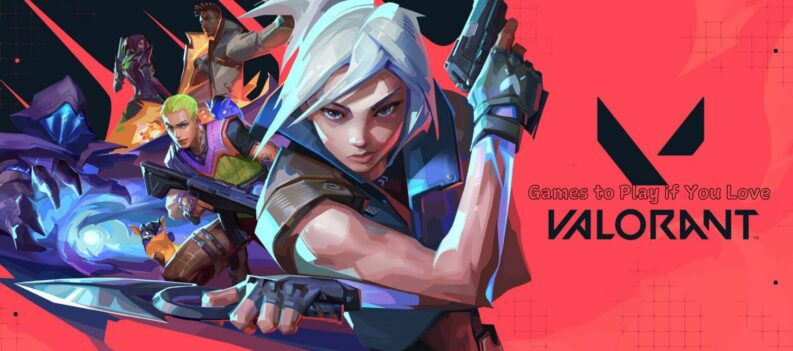Ever wondered where you stack up against the best of the best in Valorant? Read on to find out.

Life can be pretty dull when you don’t have any particular goal that you want to achieve. Goals fuel the human desire and drive to complete tasks and achieve new heights. Without motivation, humans will stagnate or regress.
Riot Games employs the same concept in Valorant. Aside from the natural satisfaction that one-tap headshots provide in-game, Riot has to provide a stimulus for its players to continue playing and griding their tactical FPS game. After all, how can players say things such as “I am the best Valorant player in the world” when they have nothing to base that claim on?
This article takes a deep dive into the Valorant Ranks, what they mean, and what to expect when playing against or with each of these ranks.
How many Valorant Ranks are there?
Currently, there are eight primary ranks in Valorant. These are:
- Iron
- Bronze
- Silver
- Gold
- Platinum
- Diamond
- Immortal
- Radiant
The above Valorant Ranks are listed in ascending order, with Iron being the lowest while Radiant being the highest possible rank.
In addition, each primary rank is further segmented into three different sub-ranks. For example, Gold is split into Gold 1, Gold 2, and Gold 3. Each sub-rank requires 100RR to rank up.
What can players expect in each Valorant Rank?
Each rank presents a unique experience that’s appropriate for their current levels. Here’s what to expect when playing in each of the Valorant Ranks.
Iron
Iron is the rock bottom of Valorant Ranks and is where most complete beginners will probably start in Valorant. The Iron rank is home to the newest of the newest players, not just in Valorant but in FPS games in general.
If you’re coming from other FPS titles such as Counter-Strike, Call of Duty: Warzone, Overwatch, Team Fortress, etc., Chances are you’ll skip the Iron rank altogether and land somewhere between Bronze and Gold, depending on how good you were in your placement matches. Otherwise, you’re going to have to settle for Iron for now.
Gameplay-wise, Iron is chaotic, but it is a fun-filled bracket of the Valorant Ranks. Most players in the Iron rank will not know a thing about what they’re doing, so everybody is probably just trying their best to learn the ins and outs of the game while having as much fun as possible on the side.
Bronze
When players from the Iron bracket no longer have thoughts along the lines of “Why did my screen go blurry when the scary-looking purple woman threw that eye-like orb into the sky?” or “How do I rotate Sage’s Wall?” then they’re most likely on their way to the Bronze bracket.
Players in the Bronze bracket will have a better idea of what most of the Agent Abilities do and how most of the Agent Abilities in-game work, so they expectedly also start to experiment with the possibilities.
However, Bronze players still do not have the team coordination and execution found in the higher ranks, so games are more or less decided by which team is luckier or has the better players.
Silver
Players in the Silver bracket have at least 50 hours worth of Valorant experience (assuming they’re coming from Iron), making them significantly more skilled than the beginners in the Iron bracket.
Silver players will have a few tricks up their sleeves, but their overall execution and timing can still be lacking. For example, Silver players will know where to smoke as Brimstone but will not know what to do after smoking off default smoke spots around the map.
Aim-wise, Silver players will know to shoot for the enemy’s head but will not have the necessary muscle memory or mechanical skill to perform these shots consistently.
Gold
Headshots become a bit more common in the Gold bracket, and players will often try to communicate and devise strategies to try and win rounds in a match.
Players in the Gold bracket will know and use a few standard lineups, setups, and smokes around every map in Valorant.
Player ego also becomes bloated in the Gold bracket. Execution can still be a bit sloppy in this rank, as players will know the when, where, what, and how to do things in-game but will still lack the timing and mechanical skill to execute, which can often lead to frustration and tilting.
Lastly, team coordination in this skill bracket is a step above the Silver bracket, and players often turn around entire games through communication and teamwork.
Platinum
Things start to get a little more serious in the Platinum rank. Platinum players are, once again, a step above Gold-ranked players in terms of aim, coordination, execution, map awareness, knowing strong angles, etc.
Headshots are plenty common in this rank, as players in the Platinum rank have spent quite a few hundred hours honing their aiming mechanics and learning about the best pre-aim angles in every map.
However, the biggest hurdles for Platinum players from progressing to the Diamond ranks are the lack of discipline and patience, as Platinum players will most likely want to take every single duel that they can to test their aim in matches.
Diamond
Diamond players rarely regress in rank, as games played in the Diamond bracket are often very coordinated and strategic. Players in this bracket play to win rather than fuel their lacking ego, so teamplay is given utmost importance here.
Drafts often play a significant role in how games are played around this bracket, and players often ‘flex’ or adjust to whatever their team requires in terms of Agents.
A Diamond player’s aim is consistent and reliable. Players know when they can and cannot peek at angles around maps, and they have a pretty good idea of the strongest pre-aim and wall bang angles in-game.
Immortal
Immortal players are closer to Radiant than most players might think.
Aiming skill, game sense, and confidence are roughly the same with Radiant players. The only real difference between the top two Valorant Ranks is their utility usage and communication.
Immortal players will have worse communication than Radiant ranked players, and by extension, Immortal games will not be as particular with utility synergy between Agents.
Lastly, even though Immortal players can seem just as cracked as Radiants, they are still nowhere near as consistent round after round as the latter.
Radiant
Radiants are at the top of the Valorant food chain for a good reason – players in this rank are more often than not pro-players from various professional Valorant teams.
Players in the Radiant rank know and understand the importance of utility and in-game economy. Utilities will be used efficiently to maximize their effects every round. Players will also try to synergize each other’s utilities through quick and concise communication.
Do we even have to talk about Radiant level aim? Just watch TenZ’s or Asuna’s highlights and prepare to catch your jaw when it drops.
Radiant players know everything there is to know about Valorant, which is why just 0.03% of the Valorant player base make it to the Radiant rank.
What is Valorant Rank Distribution in Episode 4
In December 2020, Riot Games released their API for Valorant so that third-party sources can track in-game stats and rankings.
The Valorant Rank Distribution is a percentage value derived from the total number of players versus how many of those players are currently in whatever ranks they are at.
Esportstales keeps an updated article that shows the various Valorant Rank Distribution for every rank in Valorant starting from July 2020. According to their April 2022 update, the Valorant Rank Distribution for Episode 4 is as follows:
- Iron: 12.5%
- Bronze: 26.6%
- Silver: 28.4%
- Gold: 18.1%
- Platinum: 8.7%
- Diamond: 4.1%
- Immortal: 1.6%
- Radiant: 0.03%
As you can see, more than half of the Valorant player base is sitting at around the Bronze-Gold rank bracket. Less than 15% of the player base makes up the Platinum-Radiant brackets.
Final Thoughts
Ranks can often dictate the quality of teammates and gameplay you can expect from one game to another. Most of the time, though, a player’s ranking is under the mercy of the teammates the game hands them and how they work together to win a game.
Climbing to the top of the Rank ladder in Valorant can be a daunting task, but that’s what makes this game so addicting in the first place. The skill ceiling in Valorant is very high, and there are many things to learn and consider before you’re able to rank up towards your dream Rank.
So, there you have it! We hope you’ve gained a good idea of what to expect in the various Valorant Ranks. What is your current rank? Does your in-game experience align with our outline for each rank above?
Image Credits: Riot Games















